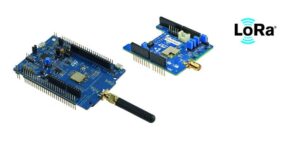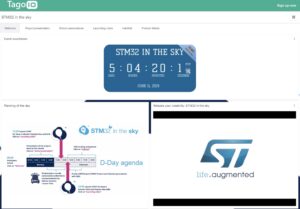Update on October 3, 2019:
We recently published the winners of our STM32 in the Sky contest, which celebrated the 12th anniversary of our STM32 family of microcontrollers. Four engineering schools launched high-altitude balloons that transmitted their GPS coordinates and other data to a LoRa gateway that enabled the public to stream an aircraft’s position live. A jury also evaluated how teams managed their project as well as the complexity and ingenuity of the systems they built. For instance, Centrale Marseille tried to measure the impact of ultraviolet rays on the stratosphere compared to its effects on the ground by monitoring yeast.
And the winner is… ISEN Toulon, with its “Game of Balloon” project that measured humidity, temperature, pressure, altitude, CO2, and magnetic fields, which can be tricky at such a high altitude. They also tested the effects of such an ascent on the Flash memory. The second place went to Polytech Marseille that designed a system that measured the pollution in the stratosphere as well as the propagation of sound waves at high altitudes. The third place is a tie between Ecole Centrale Marseille and Polytech Nice. We congratulate the four schools on amazing accomplishments, and we invite our readers to watch the video below to see each team and how they took part in STM32 in the Sky.
Text published on June 10, 2019:
STM32 in the Sky is a high altitude ballooning (HAB) contest that will take place in the south of France on June 11, to celebrate the 12th anniversary of the STM32 family of microcontrollers. Four engineering schools (École Centrale Marseille, Polytech Nice, Polytech Marseille, and ISEN Yncréa Toulon) will face off by launching balloons in the stratosphere. The French National Centre for Space Studies (CNES) and professionals and volunteers at Planète Sciences, a French association, are also our partners and will guarantee the safety of the event by ensuring, among other things, that all balloons have the proper authorizations to take off. It is thus an excellent way for us to give back to various communities and shine a spotlight on the resourcefulness, ingenuity, and creativity of these students. We will offer a live stream of the event at www.st.com/stm32inthesky.
[embedyt] https://www.youtube.com/watch?v=AiWE6vTfYow[/embedyt]
STM32 in the Sky with LoRa and a GPS

Schools will track their progress using an STM32 development board, a LoRa module, such as the B-L072Z-LRWAN1 or the I-NUCLEO-LRWAN1, the same X-NUCLEO-GNSS1A1 GNSS shield we used in the asset tracking Function Pack with TomTom, and potentially the X-NUCLEO-IKS01A2 sensor board. Alternatively, students can use our all-in-one LoRa and GPS tracker, the STEVAL-STRKT01, that shone at the last Toronto Technology Tour. Very simply, the STM32 embedded system on board captures data from the sensors and the GPS before using the sub-gigahertz module to send them to a LoRa gateway on the ground. This low-power wide-area network (LPWAN) gateway from The Things Network acts as an intermediary as it then sends the information to HABBUB tracker, a server that can track in real-time the various flights.
Each balloon will also have an HD camera to take pictures of their surroundings and a parachute to ensure a safe descent, on top of the payload embarking the STM32 system. Overall, the payload can’t weigh more than 1.8 kilograms (4 lb), as the point is to reach the highest altitude possible, usually between 25 and 45 kilometers high, depending on the ballon’s size, and potentially get some images above the earth’s ozone layer. The LoRa and GPS tracking system will also help the contestants better determine where their devices land as they must recover all balloons. Depending on the meteorological conditions, they can travel great distances, and geolocation is crucial to retrieving them. Additionally, a predictor tool on HABBUB will help students anticipate where the aircraft will land.
STM32 in Your Sky, Follow the Event and Start Your High Altitude Balloon

To make this event more interactive with our global community, we partnered with TagoIO, an IoT application server that will serve as a central system to follow the game. It will access data from the HABBUB servers and offer live tracking of the various data and the balloons’ geolocation. Users will also be able to follow the day’s agenda, the school’s presentations, and see a live stream of the event. Students will try to share their experience and results with the community to benefit other schools, hobbyists, and engineers that are into high altitude ballooning, but in the meantime, TagoIO will help our online communities feel that they are also part of this event.
In the meantime, people interested in tracking objects can look at our FP-ATR-LORA1, a Function Pack that will help developers start their tracking application using LoRA. Anyone using the same boards as the students participating in the STM32 in the Sky contest can drag and drop the pack’s precompiled binary onto the Nucleo board’s storage and start registering their device. We offer a Quick Start Guide that will walk users step by step to ensure they can start using the demo application in just minutes. Since the Function Pack also contains our source code, developers can then integrate our files in their IDE and use them as a stepping stone to build their application. Furthermore, enthusiasts can use our new and free STM32CubeIDE to start writing code in a modern and feature-rich tool without having to purchase expensive licenses.
